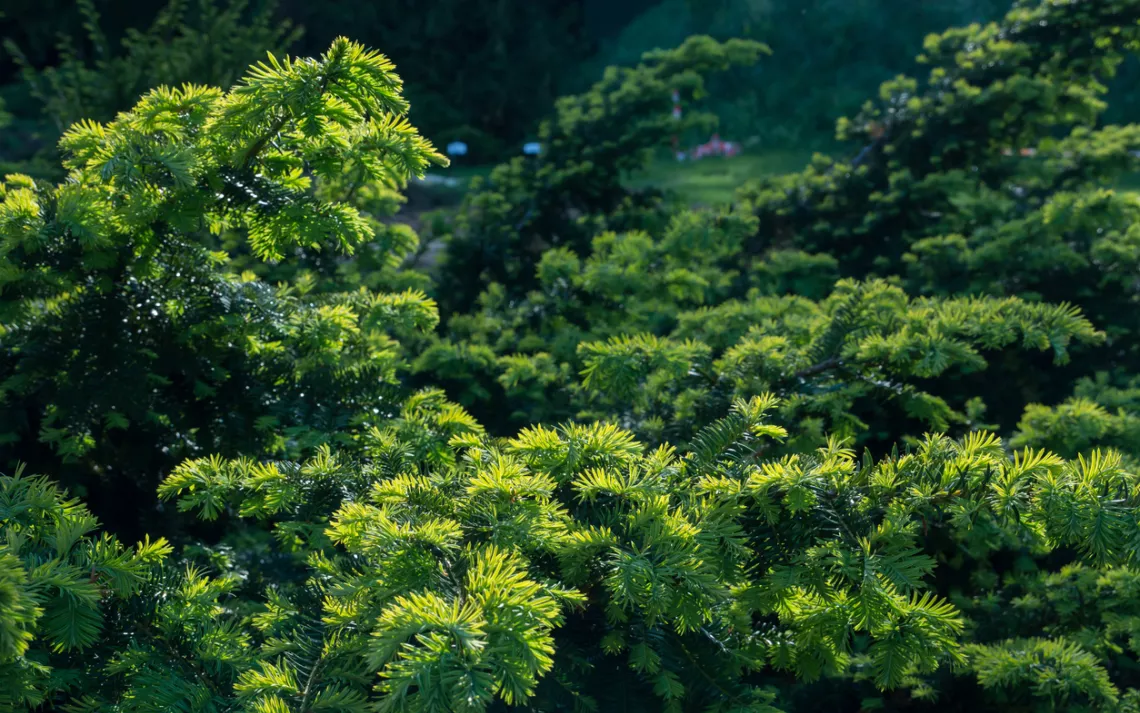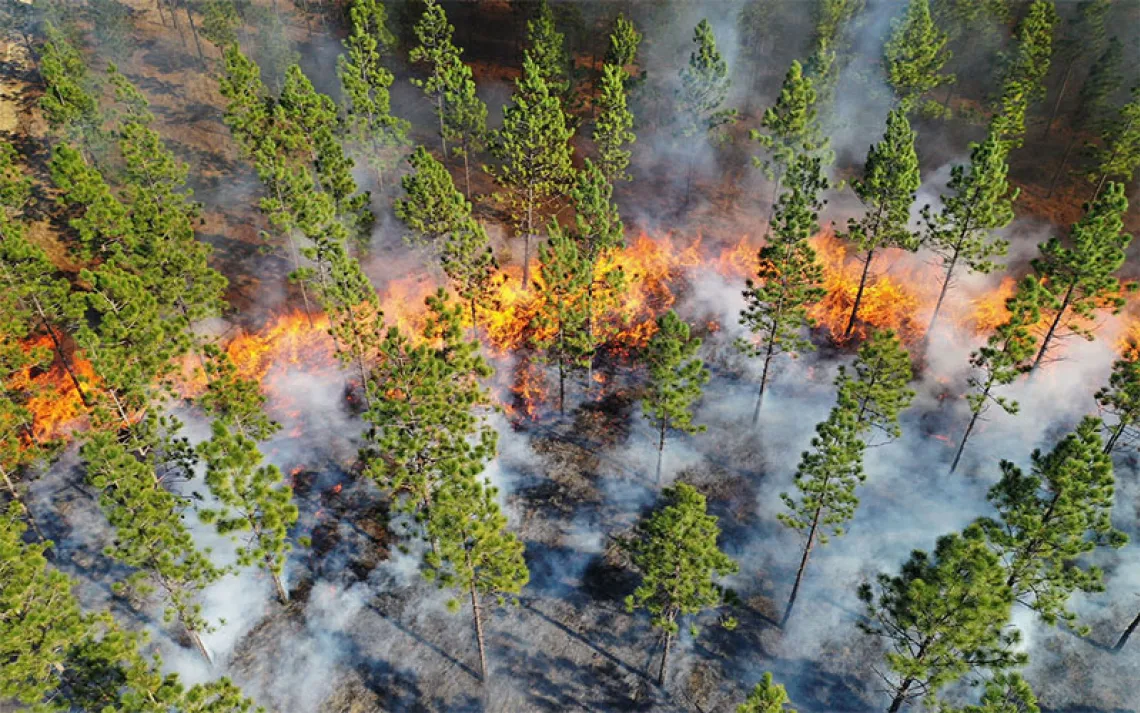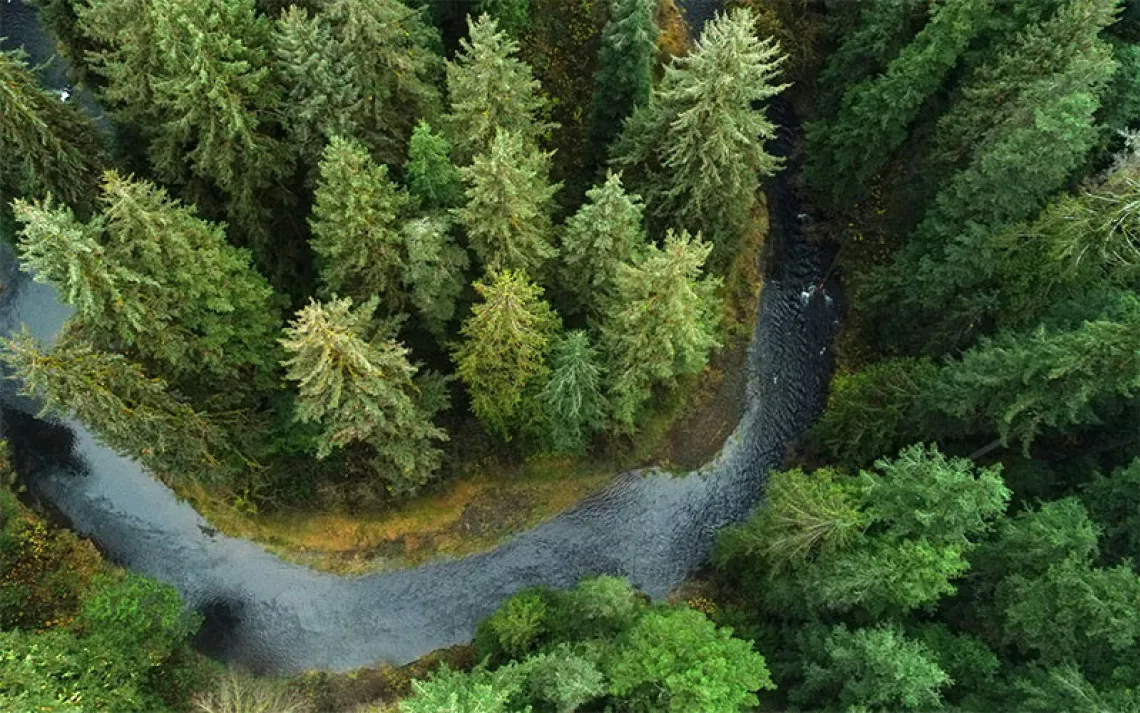American Roots: A tour of old-growth forests around the United States
Eastern hemlock, bald cypress, and ponderosa pines

Eastern hemlock
The term "old-growth forest" may conjure images of the West’s majestic redwoods and Douglas firs. But stop there and you deny yourself the graceful pyramid form of an eastern hemlock, the massive buttresses of a bald cypress rising from an ink-black bayou, or the park-like expanse of a ponderosa pine forest.
Old growth is found in nearly every state in the nation, ranging in size from several acres to well over 20 square miles. While biologists have no concrete definition of the term, it generally refers to forests that have suffered little or no logging or livestock grazing, and appear largely as they did prior to European colonization. Naturalness and age rather than tree size alone distinguish an ancient stand.
Yet not all trees in old-growth forests are old. These woods are mosaics, a mix of saplings, mature trees, and trees 150 years or older. (In western conifer country, for example, old-growth forests are generally considered those with at least eight trees per acre exceeding 200 years in age or 32 inches in diameter.) While 360-foot-tall California redwoods are hard to miss, the largest trees in old-growth eastern or midwestern woods might, at around 150 feet tall, be only 20 to 30 percent larger than midsize specimens nearby. What catches the eye of the forest ecologist are the common traits of many ancient groves: deep, multilayered canopies; an abundance of shade-tolerant understory plants; plentiful snags and downed trunks; and trees with heavy limbs, spiky tops, craggy silhouettes, and contorted, leaning, or spiral trunks rutted with cavities.
Besides genetics, factors that keep most eastern old growth from soaring to the skies are thin, rocky soils and frequent hurricanes, windstorms, and ice storms. The tallest tree in the eastern United States, a 207-foot white pine growing among other giants in the Cataloochee Valley of Great Smoky Mountains National Park in North Carolina, wasn’t discovered until 1995—and promptly lost its topmost 35 feet when Hurricane Opal tore across the South that fall, nearly losing its title in the process. (The most ancient eastern forest is also found in North Carolina: a stand of 1,700-year-old bald cypresses at the Nature Conservancy’s Black River Preserve. More common eastern species like red spruce live only about 400 years.)
The most significant reason that old growth is rare, of course, is that so much of it has been cut for timber. Just 500,000 acres of old-growth forest remain in all of New England and New York. In fact, more than 99 percent of eastern old-growth forests, and more than 90 percent on the West Coast, have been heavily logged. At least half of what’s left in the East is still open to logging, according to the Kentucky-based Eastern Old Growth Clearinghouse.
Much more than curiosities, ancient forests are nurseries of biodiversity. Abounding with live and dead trees, decaying logs, and thick layers of moss and leaves, they provide flourishing wildlife habitat. Birds thrive in their high canopies and trunk crevices, while fish benefit from the nutrients their woody debris provides to sheltered streams. An exhaustive University of Wisconsin study of northern forests found that old-growth areas had the "highest bird densities and species richness." Even-aged, managed sites (like tree farms) were the least diverse. Biologists traced the decline in 11 species of old-growth-dependent birds in Southern California’s San Jacinto Mountains as logging continued over a 30-year period. Nature writer Robert Michael Pyle (who holds a doctorate in forestry and environmental studies) says a visitor can sense the difference immediately: "The industrial woods may be deep, they may be dark, but they are not diverse. You couldn’t imagine Sasquatch lurking in such a stand; your children would not look for leprechauns behind the shamrock sorrel. It takes time, lots of it, to make such a place."
In the following pages, we highlight a few of the country’s lesser-known old-growth forests, from Massachusetts to the Carolinas, Mississippi to California. They’re all accessible to the public; we hope you’ll plan a visit, crane your neck, and discover for yourself what "old growth" means.
Reed McManus is a senior editor at Sierra.
SEE A TREE
Want to gape at an ancient grove? Then you should join a Sierra Club outing and head into one of America’s old-growth forests.
This time of year, you might prefer the southern latitudes, kayaking the everglades (January 6–11), where you can take in mangrove forests and bald cypresses; paddling Florida’s St. Johns River, following the route of naturalist William Bartram (February 16–22); or kayaking amid Suwannee River cypresses in Georgia and Florida (two trips: March 30–April 4 and April 13–18).
If you’re more of a landlubber, you can help maintain trails in Ocala National Forest, home of the world’s largest continuous sand pine scrub forest, while enjoying hikes along the Florida
National Scenic Trail (February 23–March 1), or ramble around some of the tallest and oldest trees in the eastern United States in North Carolina’s Nantahala National Forest, while building and restoring scenic trails on another Club service trip (March 30–April 5). Or explore the Nantahala area, while staying at the forest’s Tapoco Lodge (April 6–12).
For more information, including additional trips, go to www.sierraclub.org/outings/national, or contact Sierra Club Outings at 85 Second St., 2nd Floor, San Francisco, CA 94105; (415) 977-5522.
EASTERN HIDEAWAY
Encompassing slightly more than half a million acres along the Tennessee–North Carolina border, Great Smoky Mountains National Park supports the second-largest remaining stands of old-growth forest in the eastern United States. Some of the park’s trees, which include red spruce, hemlock, and yellow buckeye, are more than 150 feet tall and 4 to 6 feet across.
Up to 70 percent of the trees in the region were logged before the park was established in 1934. Poplar became lumber; chestnut and hemlock produced tannin used in tanning; oak, maple, and cherry were crafted into furniture and flooring; and red spruce was pulped into paper. The latter was also cut during World War I because its strength and light weight made it ideal for military airplanes.
But the park’s steepest, most remote slopes have always protected some of its oldest trees. Just this summer, the park’s forest ecologist discovered a 278-year-old pignut hickory growing on a rock outcrop. Because the thin soils there hold very little water, it was only 16 inches in diameter. Although trees were cut from surrounding areas prior to the establishment of the park, specimens like this one were so small and inaccessible they weren’t worth the effort required to cut them down.
SAVED BY THE SWAMP
Buttressed trunks (called "knees") are telltale signs of mature bald cypress, like the champs in the Cypress Preserve in Greenville, Mississippi. Similarly grand cypress can be found in the Atlantic and Gulf coastal plains from Delaware to Texas, and in the Mississippi River valley north to southern Illinois, where the trees grow to 150 feet tall and 6 feet across. (Bald cypress gets its name, by the way, because it’s one conifer that sheds its leaves in winter.)
Commercially prized for their lumber, most bald cypress forests were decimated by 1930. What remains today was either too remote or too young at the time to be sawed into planks, the best of which were often five feet wide. Swamp forests of bald cypress and tupelo grow in low-lying areas such as floodplains or abandoned river channels. Normally separated from a river, much of this swampland is flooded year-round, with the water standing up to several feet deep.
MEMORIES OF THE HEARTLAND
Lost to farms or cities, only about one percent of hardwood forests in America’s heartland remains as biologically viable wildlife habitat. A 350-year-old bur oak in Missouri’s Big Oak Tree State Park is an example of the drought-resistant trees that once thrived in the Midwest. The region’s dense oak-hickory forests yielded to savannas as you headed north from the Ozarks, and in some areas intermingled with the native prairie.
What wasn’t torn up and developed was obliterated by years of fire suppression: In the absence of regular blazes, oak savannas—characterized by scattered trees with sparse understory and rich with grasses—must compete with colonizing native and exotic trees and shrubs. Without fire, these invading species can eventually replace the oaks. Efforts are under way to introduce prescribed fires to restore pre-European savanna conditions.
THE GREATEST NORTH WOODS
You don’t have to head to the coasts to find deep, dark, ancient woods: Try Michigan’s Upper Peninsula, home to Porcupine Mountains Wilderness State Park, at nearly 60,000 acres the last extensive tract of old-growth forest remaining in the Midwest. Its remote and rugged interior shelters towering pine and hemlock. Several hemlock groves, in fact, are more than 300 years old, and the park harbors record-size specimens of sugar maple, American basswood, and yellow birch. Though a visit here takes you about as far north as you can go in the Lower 48, the tempering influence of the Great Lakes produces forests that are more closely identified with warmer, more humid southeastern forests than with the colder, boreal regions to the north.
"The Porkies," as they’re known to locals, also provide some of the best recreation in the Midwest: The state maintains 16 rustic trailside cabins for public use and 90 miles of foot trails that lead to placid lakes, churning rivers, and rocky cliffs with views of the park, Lake Superior, and the Apostle Islands.

Sign up to receive Sierra News & Views
Get articles like this one sent directly to your inbox weekly.
With this action you affirm you want to receive Sierra Club communications and may vote on policy designated by the Sierra Club Board.
Considering that only 20 percent of western Great Lakes forests remain unfragmented, the Porcupines are a rare natural treasure. Most of the original white and red pine forests outside the boundaries of protected areas like Porcupine Mountains State Park have been logged for paper mills and replaced by younger stands of birch and aspen.
FORESTS THAT NEED FIRE
Fire suppression, grazing, and logging of the heftiest trees (a process the timber industry calls "highgrading") have been responsible for massive damage to the West’s ponderosa pine forests, like a grove in California’s Plumas National Forest, where the world’s tallest ponderosa lives.
A natural ponderosa forest is open and parklike, the product of low-intensity wildfires, which burned every 2 to 12 years before European settlement. These blazes cleared the forest floor of litter and allowed for reseeding of new grasses and other understory plants. Without these periodic fires, ponderosa forests develop understory thickets of shade-tolerant species like Douglas fir.
In these crowded stands, trees become increasingly susceptible to attack by insects and pathogens, blowdowns in storms, and catastrophic crown fires as live and dead forest fuel builds up.
An example of the predicament is the forest that stretches some 120 miles from near Flagstaff, Arizona, east along the Mogollon Rim to the White Mountains region, the largest ponderosa pine forest in North America. Today it is characterized by "dog hair" thickets of young pines with a heavy accumulation of litter on the forest floor. A sizeable fire under these conditions can destroy entire stands.
SHORT AND VENERABLE
Size alone gives no hint of forest age. Stunted pitch pines, like those near Lake Minnewaska in New York’s Shawangunk Mountains, may be a century or two old. Nutrient-poor soil and exposure to sun and wind yield gnarly and twisted trees. Additionally, wildfires remove fledgling hardwoods and regenerate the pine.
But the landscape is far from barren. Joining these trees are well-adapted blueberry, huckleberry, and sheep laurel, as well as a variety of mosses. Though a 40-foot-tall pitch pine is a giant, you can also find 100-foot-tall hemlock and yellow birch in well-protected and well-watered ravines—just 90 miles from Manhattan. With all but 2 percent of New York’s pitch pine barrens already lost, Minnewaska State Park’s 6,000 acres are as much museum as "preserve."
A NATURAL LANDMARK
Eastern white pine and hemlock inspire reverence in the Forest Cathedral Natural Area of Cook Forest State Park, one of the largest old-growth stands in Pennsylvania. Many of these trees approach 200 feet tall and 300 years in age, earning them the moniker "William Penn Trees" after the first governor of "Penn’s Woods." The Northeast’s tallest white pine, the 180-foot Longfellow Pine, is just one standout in the 7,200-acre state park, one-fifth of which is covered in old-growth. Thickets of great laurel rhododendron brighten the understory.
It’s nearly a miracle that so much ancient forest survives today, because the trees were at the center of a late 1800s logging boom that supported a frenzy of shipbuilding and construction. But in the 1920s, the Cook Forest Association formed to save the few surviving old-growth areas on vast acreage owned by the A. Cook Sons Company, which had been logging in the region for nearly a century. The association, endorsed by then-governor Gifford Pinchot (first chief of the U.S. Forest Service), helped purchase the land from the Cooks. It was the first Pennsylvania state park acquired to preserve a natural landmark.
LOADED FOR BEAR
Massachusetts’s Mohawk Trail State Forest in the Berkshire Mountains earns its ancient-forest status easily. It’s thought to harbor the tallest white ash and American beech in the entire Northeast, and the tallest red maple, white pine, and sugar maple in New England. Along with hemlock and beech, the sugar maple is a classic component of an old-growth New England forest.
Another telltale sign of ancient woods is a preponderance of coarse woody debris, the dead limbs, large stems, and other material that provide rich habitat for wildlife. One study found that part of the Mohawk Forest showed accumulations of 30 tons per acre of such material, compared to 9 tons per acre in a nearby second-growth stand. The 6,450-acre forest’s five stands of old growth are excellent places to see large mammals: Once rare, an estimated 1,000 black bears now roam the woods of western Massachusetts. Savvy bear-watchers look for claw marks in smooth beech bark.
OLD AGAINST ALL ODDS
You have to rethink definitions of old growth when it comes to Florida. By 1940, virtually all trees in the state that were valuable as timber had been logged, and much of the land had been turned to pasture. Real-estate speculators had developed huge wild tracts into subdivisions, and invasive plants like peppertree and melaleuca were taking their toll. On top of all this, natural disturbances such as fire, hurricanes, and floods are routine occurrences in the Sunshine State. So the classic concept of a "climax" forest does not apply in a region where only isolated pockets of slash pine, which occupies the highest and driest land in the state, escaped regular burning.
But Florida does offer a good variety of old growth, including bald and pond cypress forests (the state’s tallest tree is the Senator, a 115-foot-tall bald cypress in Spring Hammock Nature Park near the St. Johns River); scrub cypress, which was overlooked by loggers intent on felling the heftier big cypress; longleaf pine (a fire-sensitive species once found throughout the southeast coastal plain); and the mangroves that protect low-lying southern Florida and wildlife like the roseate spoonbill from the wrath of hurricanes.
 The Magazine of The Sierra Club
The Magazine of The Sierra Club



